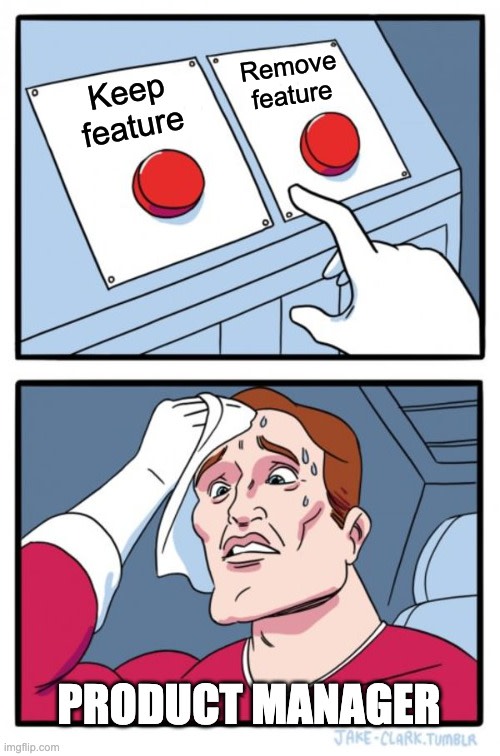
Ask most product managers and they’ll agree that you shouldn’t put features in your product that people don’t use.
The tricky part is that sometimes the only way to know for sure whether people will use a feature is to actually build it, and then measure the results.
You also want some way to know whether people are using the features that are already in your product so that you can decide whether to keep those features in your product and identify when you need to improve some features.
So how do you measure whether people are using the features in your product?

What is Feature Adoption?
Feature adoption is the set of metrics you can use to determine if your users are using the features in your product. These metrics tell you how many users try out your new features and continue to use them. Insight from those metrics help you decide whether to continue to invest in a feature or if you should focus elsewhere in your product.
Adoption is part of the HEART Framework, designed by UX Research experts at Google to bring your product team’s focus in line with your user’s experience.
HEART stands for five metrics Happiness, Engagement, Adoption, Retention and Task Success that help you gauge how users interact with your product.
If you’re working on a product-led SaaS product, you may also include adoption as a third A in the AARRR framework (aka Pirate Metrics). Once users Activate (the second A) you’ll also want to monitor their adoption of additional features in your product. When users adopt multiple features, they’re more likely to continue using your product thus helping your retention metrics.
How to measure feature adoption
The simplest way to measure feature adoption is via the feature adoption rate. It is the percentage of active users who used the feature at least once during a time period.
To calculate the feature adoption rate for the month of January, divide the Monthly Active Users (MAU) of a feature for the month of January by the total number of users your product had on January 31.
You may be asking “What is a good feature adoption rate?” That’s a good question without a clear answer.
A desirable rate varies from one product to the next based on your product’s characteristics and target market. For example, a good feature adoption rate in a B2B product with few users is going to be considerably higher (because you have fewer overall users) than for a B2C Product.
To identify a target feature adoption rate for a feature in your product, your best bet is to compare it to similar products that focus on the same target market.
To get a complete picture of the feature adoption in your product, you need to look at a set of metrics. Here’s a set of metrics that shows the use of your product’s features along a variety of dimensions.

Depth of Adoption
While it’s helpful to know how many users overall interact with your feature, it’s even more helpful to know which users are the most active. Depth of adoption measures which key user types use a feature. This metric can help you identify issues with feature relevance. If a certain user type does not use a feature as much as you think they should, that’s a sign that you may need to tweak that feature.
To measure depth of adoption, identify the key user types you’re interested in. They could be new versus existing users, or users who fit within specific personas. Then, determine the feature adoption rate for each user type within the same time period.
Time to Adoption
You’ll also find it helpful to know how long it takes users to use a feature for the first time. You want to know how long it takes new customers to start using existing features so you can identify ways to keep those new customers around..
You also want to know how long it takes existing customers to adopt new features so that you can improve retention. In both cases, knowing how long it takes users to start using a feature can identify issues in onboarding and user experience.
To measure time to adoption, track the time between when a feature is available to users and when they first use that feature. The starting point changes depending on whether the user is new or existing and the feature is new or existing:
If the user signed up after the feature is available, your starting point is when the user signed up.
If the user signed up before the feature was available, your starting point is when the feature became available.
It can also be informative to track how long it takes users to start using a feature when they find out about it. If there’s a delay between awareness and first use, you may have a problem with messaging, or the feature does not interest them.

Duration of Adoption
In most cases, a successful feature is one that people use repeatedly. To know whether your users are sticking with a feature, it’s helpful to track how long users continue to use a feature. This isn’t how long they spend using a feature in any instance, but whether they continue to use a feature over multiple weeks or months.
The duration of adoption measure gives you a sign of retention for that feature and helps you determine if users see value in the feature.
To measure duration of adoption, you can use the retention rate. This metric shows what percent of users of a feature continue to use it after a certain time period. Dive the number of users who use the product after a certain time period by the total number of people using the feature.
For example, you may have a 3 month retention rate that shows the percentage of users who continue to use a feature for three months after first adopting it.
How to Increase Feature Adoption
Now that you’re able to measure your features’ current adoption, here are some steps you can take to improve the adoption of those features that you want to keep in your product.
Educate users about the value of the feature
Your users need to know that a feature exists but they also need to know what the feature will do for them. Identify ways to inform your users of the benefits they’ll get from using the feature. Start by identifying a problem the feature helps them solve and then explain how the feature will help them solve it.
You can communicate that message through in-app messaging, written tutorials, or instructional videos.
Simplify the user experience
Once you get people to try a feature, you want to make sure they continue to use it. The likelihood that your users will slog through a difficult user experience is pretty low unless they get value from your feature they can’t get anywhere else.
It’s best to not leave that to chance. So make sure that your feature’s user interface is clear and intuitive. An experienced user should be able to use the feature with no interruption and a new user should be able to access help when they need it.
It’s also a good idea to design the user interface to protect users from making errors that would hinder their experience, and when there is an error your feature should handle it gracefully. Explain what went wrong and explain how the user can resolve the issue.
Offer in-app support and guidance
No matter how intuitive you make your feature, there are going to be times when users face a unique situation, or need a bit more help. If there are situations where the design of the interface alone won’t help your users accomplish the task they’re trying to complete, provide an alternative means for them to get help.
To accomplish this, you can provide a knowledge base or live chat support to help your users resolve issues they run into when trying to use the feature.
Training sessions or webinars can also be helpful to get new users up and running or to introduce existing users to new features.

Conclusion
If you want to be an effective product manager, you need to have a good handle on the feature adoption for your product.
When you track the feature adoption metrics described in this article, you’re in an excellent position to identify which features you need to tweak to keep your existing users and attract new users. You also may identify features you can remove to ease maintainability and make your products less complex.

Kent McDonald

Read also





Experience the new way of doing product management

Experience the new way of doing product management



